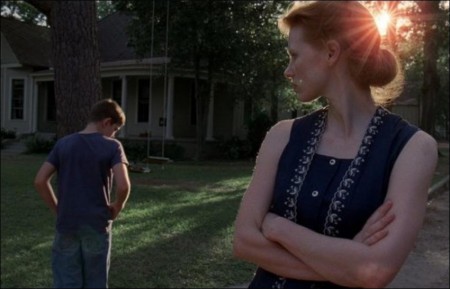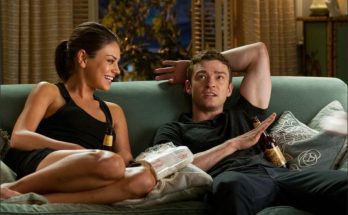From Terrence Malick, the acclaimed director of such classic films as Badlands, Days of Heaven and The Thin Red Line, The Tree of Life is the impressionistic story of a Midwestern family in the 1950’s. The film follows the life journey of the eldest son, Jack, through the innocence of childhood to his disillusioned adult years as he tries to reconcile a complicated relationship with his father (Brad Pitt).
Jack (played as an adult by Sean Penn) finds himself a lost soul in the modern world, seeking answers to the origins and meaning of life while questioning the existence of faith. Through Malick’s signature imagery, we see how both brute nature and spiritual grace shape not only our lives as individuals and families, but all life.
The Beginnings
Terrence Malick has always created thought-provoking, intensely visual and viscerally emotional films of our times, each one a distinct experience rife with mystery and depth. His new film, THE TREE OF LIFE, may be simultaneously his most intimate and epic work yet – a quest that traverses from today’s urban corporate towers to a 1950s Texas family’s back yard, and at the same time, from the beginnings of life on earth to the end of the known universe, in search of what is true, what is lasting, what is infinite.
The story unfolds symphonically, like a piece of music divided into movements, or the limbs of a towering tree, tracing the evolution of a single life – that of Jack O’Brien, who is trying to square a series of lingering questions about his father’s anger, his mother’s love, his brother’s death, and his own struggles with meaning and faith. But Jack’s story plays out within the vast beauty and the recursive rhythms of the universe itself.
His human struggles become part of the cosmos’ vast creative and destructive powers, as he begins to sense his connections to the dust of the stars, to the prehistoric creatures who once roamed the earth and to his ultimate destiny. It is a deep love story about how love emerges from life and life emerges from love.
THE TREE OF LIFE is an open-ended journey into uncharted territory for contemporary movie audiences, one that will no doubt impact each person in a unique way. As Malick enters such nebulous, imagination-rich worlds as childhood memory, pre-human history and the burning realm of the stars, the story plays out both at the microscopic level of the heart and at the unfathomably massive level of eons and eons of time, with both always in motion.
Sarah Green, who also produced THE NEW WORLD, was awed and excited by her initial encounter about the project. “Terry showed me an early treatment and I remember thinking immediately that this film had to be made – and that I would do everything possible toward that end,” she recalls.
Says Green, “The very title of the movie brings up so much. The ‘Tree of Life’ is a key symbol in many of the major religions and in Darwinism as well. It brings up nature; it brings up spirit. Everyone has a reaction to those words.”
“Terry has his own unique cinematic language,” notes producer Grant Hill, who previously worked with Malick on THE THIN RED LINE. “No one else talks the cinematic language that he has invented, in a sense. He has this wonderful gift of being able to really make you feel that you are there, that you know his characters. And with THE TREE OF LIFE, he takes that film language somewhere new in order to draw the audience into an original journey, to take a leap of faith, and to allow them to bring parts of their own life experiences into the canvas of this story – a story that is very much about a single family but also, simultaneously, the creation of the cosmos.”
The script would go through its own process of evolution, unfolding in new ways at every turn, yet always kept wide open to other possibilities as part of Malick’s process. It quickly attracted additional producers who had been in touch for several years with Malick, hoping to work with him on impending projects: River Road’s Bill Pohlad and Plan B partners Brad Pitt and Dede Gardner.
Says Pohlad of his reaction to a script that was a highly unconventional read, “It was an amazing piece of writing but not like anything I had read before. Basically it was like a poem. I don’t know what I was expecting when I started to read it, but it just hit me on a very emotional level. It was an amazing, powerful script that balanced a profound intimacy with an epic scope.”
Continues Pohlad, “There’s a powerful connection to be made between the universal and the personal. The beauty of THE TREE OF LIFE is the organic weaving together of the two.”
Gardner, who notes that seeing DAYS OF HEAVEN years ago blew her mind and inspired her own career in film, adds, “I was shocked by how moved I was by the script and I took a very particular thing away from it inside myself but I think different people will take different things away from it, and that is the real beauty of what Terry does in THE TREE OF LIFE.”
She goes on, “For me, this family’s story and what it tells us about ego, shame, humility and grace becomes so much more accessible because it is put so beautifully into the bigger context of a timeless, borderless world. What’s so amazing to see is how Terry can bring all these vast layers of perspective – so enormous in size and scope – to it, without ever altering the feeling that this is an incredibly intimate and poignant family story.”
As the film moves outward into time and space, it creates images largely unseen in the pantheon of motion picture history: images of the universe and earth forming out of explosive chaos, then growing and evolving into the stunning structures of life. Malick consulted with an array of scientists from around the world to better understand all the forces at work — the physics, astronomy and biology—in what he was attempting to capture and, for the first time in his career, he worked extensively with visual effects. He did so in concert with the accomplished team of Douglas Trumbell of 2001: A SPACE ODYSSEY fame and veteran visual effects supervisor Dan Glass (MATRIX RELOADED, V FOR VENDETTA).
“I don’t think I’ve ever seen any director try to authentically render the beginnings of the universe in a feature film before,” states Gardner. “I think it’s magical. I could watch hours of it. But beyond its beauty and wonderment, what’s so impressive is the way Terry weaves that all into the film, allowing you to see that this family, this father’s ego, these struggles that Jack feels inside are so miniscule and temporary in the face of it.”
Sums up Green, “It’s an extraordinary experience and one I don’t believe filmgoers have had before, particularly the way Terrence Malick brings nature to the screen in all its wild, extreme glory.”
Though a strand of specific themes weaves through all of Malick’s films – the contrast of innocence and violence, nature and spirit, stark reality and transcendent beauty – there is something else that unites them: they aren’t so much films a person watches but experiences a person inhabits.
The Visuals
In the midst of creating the full breadth of THE TREE OF LIFE, Terrence Malick would put on film some of the most primeval, chaotic and seemingly unknowable moments that have ever percolated in the human imagination.
These include the formation of the universe in a stunning blast of cosmic power 14 billion years ago; the formation of Earth from the accretion of solar nebulae 4.5 billion years ago; the appearance of the first single-celled life forms in the Proterozoic Eon; the 160 million years during which dinosaurs reigned as the most dominant and complex beings on the planet; and the universe’s ultimate fate projected billions of years from now when our sun has become a white dwarf and the scattered remnants of Earth trail behind.
To create all of this in an authentic way would mean using extensive visual effects for the very first time in Malick’s career. It would also mean doing so with an original approach that would jibe with Malick’s aesthetic sensibilities – mixing Old School paint-and-water effects with the latest in digital generation to find an organic, even emotional, feeling within these seemingly spectacular, mind-boggling events which are of course nature, played out on the screen.
Years ago, when the project was still just a seed of an idea in his mind, Malick began consulting with Douglas Trumbull, a pioneer in the inventive use of special effects, most renowned for immersing audiences in outer space for Stanley Kubrick’s masterwork 2001: A SPACE ODDYSEY. Trumbull went on to create effects for Steven Spielberg’s classic CLOSE ENCOUNTERS OF THE THIRD KIND, Ridley Scott’s BLADE RUNNER and the first STAR TREK movie, as well as directing such sci-fi films as SILENT RUNNING and BRAINSTORM.
Though he has not worked in Hollywood for years, Trumbull was drawn to Malick’s vision for THE TREE OF LIFE. For one thing, Malick wanted every image to feel like a natural phenomenon, which meant relying as little as possible on computers, and using what Trumbull dubs “Non-Computer Graphics.”
“Terry and I share a perspective on visual effects and imagery as it pertains to wanting to get to something that’s completely organic. We both want to push into new territories of what film can actually be. It wasn’t that we didn’t use computers on this film – we used a lot of them and there are some truly amazing computer graphics,” explains Trumbull. “But, for example, when you see the dinosaurs they look like truly living creatures and they are then super-imposed into a world that is completely real. It’s not a synthetic world with a synthetic creature in it. Only 10 to 20 percent of what you’re seeing is computer-generated, but you can’t tell which part of the frame is computer generated and which part is real which fits into Terry’s naturalistic world.”
Trumbull had fallen in love with Malick’s naturalism as soon as he saw DAYS OF HEAVEN while he was then working on STAR TREK: THE MOVIE. “I was really impressed that the movie had such a profound effect on my memories. It was a very ethereal, experiential movie that was trying to break the language of cinema,” he observes. “What I like about Terry’s films is that it’s more of a poetic film style. He’s constantly trying to learn something, which is rewarding.”
When he read a script for THE TREE OF LIFE, he was overtaken by its creative possibilities. “It takes a simple human story and puts it in the spectacular framework of the beginning and end of the universe and the infinity of life,” Trumbull says.
Soon after, Trumbull and Malick began a series of hypothetical conversations about how some of the sequences in Malick’s vision could best be created. “We talked about doing many of the intergalactic effects he wanted the way that we did things many, many years ago — using water and paint and high-speed cameras,” Trumbull explains.
They also talked a lot about astronomy in general, says Trumbull, “about the workings of the universe, the Big Bang Theory, cosmic expansion, general relativity and how they might all fit together. Terry wanted to explore these ideas as an artist, not a scientist, to take film into new territory. He would talk about certain things he wanted to see – protostars [the earliest conglomerations of dust and gas becoming stars], accretion disks [a rotating disc of gas and dust that forms around stars and other massive space objects], the sun turning into a Red Giant [a star in the last stages of its life which has expanded after core collapse] – and we would talk about how it might be done.”
Then Trumbull put together a kind of secret laboratory in Austin, Texas, dubbed the “Skunkworks,” where they began to experiment. “We worked with chemicals, paint, fluorescent dyes, smoke, liquids, CO2, flares, spin dishes, fluid dynamics, lighting and high speed photography to see how effective they might be,” he says. “It was a free-wheeling opportunity to explore, something that I have found extraordinarily hard to get in the movie business. Terry didn’t have any preconceived ideas of what something should look like. We did things like pour milk through a funnel into a narrow trough and shoot it with a high-speed camera and folded lens, lighting it carefully and using a frame rate that would give the right kind of flow characteristics to look cosmic, galactic, huge and epic.”
To keep the creativity flowing, Malick did not use typical storyboards for these sequences. “He didn’t want a mechanistic approach that would be set in cement,” observes Trumbull. “He would rather have mysterious phenomena spontaneously occur while the camera was rolling.”
This process of experimenting and shooting individual effects went on for well over a year. “All along,” says Trumbull, “Malick was hunting for the Tao, that completely unanticipated phenomena, those magical unexpected moments that no one could possibly design.”
That hunt proved to be very satisfying. “I’m very proud of how it all worked and all that we discovered,” concludes Trumbull. “I hope the result is a kind of experiential, immersive cinema that goes beyond words and beyond the envelope of a conventional Hollywood movie.”
About four years ago, producer Grant Hill also brought in Dan Glass to work in concert with Malick and Trumbull on the high-tech end of the visual effects. The request from Hill took Glass aback, “As a visual effects professional I never imagined I would have the opportunity to work with a filmmaker like Terrence,” he explains. “It was very exciting.”
The process was quite different from what he had experienced on some of cinema’s biggest action, fantasy and sci-fi blockbusters, including MATRIX RELOADED and BATMAN BEGINS. “Visual effects are normally very systemized, very planned out at the earliest stages,” he comments, “but Terry was more interested in creating vignettes that really communicate emotion and mood and are more spontaneous feeling.”
In keeping with that process, Glass never learned the full story of THE TREE OF LIFE, or anything about the O’Brien family. He was only made aware of the sections of the film tracing the history of the universe, the earth and nature itself.
The Tree of Life
Directed by: Terrence Malick
Starring: Brad Pitt, Sean Penn, Joanna Going, Dalip Singh, Fiona Shaw, Jessica Chastain, Nicolas Gonda, Tye Sheridan
Screenplay by: Terrence Malick
Production Design by: Jack Fisk
Cinematography by: Emmanuel Lubezki
Film Editing by: Hank Corwin, Jay Rabinowitz, Daniel Rezende, Billy Weber, Mark Yoshikawa
Costume Design by: Jacqueline West
Set Decoration by: Jeanette Scott
Art Direction by: David Crank
Music by: Alexandre Desplat
MPAA Rating: PG-13 for some thematic material.
Studio: Summit Entertainment
Release Date: May 27, 2011
Hits: 84










